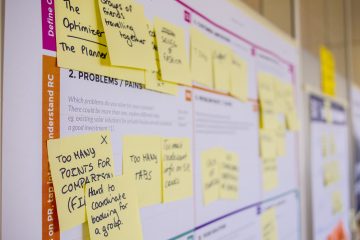Design Thinking & Service Design
Problem Identification
The greatest power of design isn’t in the design stage, it’s in first identifying the REAL PROBLEM. It’s an art form and we can make you experts. The beauty of Design Thinking and Service Design is allowing a space for creative thinking and thinking differently about solving problems. When we think about a problem outside of the system constraints, office politics, outdated hardware, and crippling roadblocks we’re trained to identify, only then can make a true and meaningful difference with design.
We offer workshops and exercises to get to the heart of the problem, so that all of our work creates meaningful solutions.

Personas & User Types
User Types and Personas are two tools that provide an in-depth and empathetic view of who those interested in your products and services. Identifying user types is the first step when thinking about your planned experience. We know different people have different needs and motivations and may want to accomplish different things based on their goals, financial standing, and stage of life. Personas help explore these needs in depth.

Workshop Design & Facilitation
We run workshops specific to Design Thinking and Service Design and they are never, ever the same. We’re surprised and delighted by the insights and ideas within teams who have worked together for years but never really talked about their services, their frustrations and most importantly, their ideas.

Interviews & Shadowing
We’ve worked with clients who are terrified to have their customers, patients, or members interviewed and need three months’ notice to do so. We teach clients about gathering information quickly and effectively, on a lunch break, on the street, or the next office in their building. The secret? People want to help; they want to share an opinion and you can ask them for it. We can do it for you, and train you how to continue your “research in the wild” in the future.

Journey Mapping
Journey Maps are Service Design royalty. We love them and have used them for patient journeys, software purchase and on-boarding, banking, and education. Journeys carry forward the idea of empathy from personas. They allow us to walk in the shoes of a person on a mission to complete a task.
What channels will they use for what? What frustrates them getting from point “a” to point “b?” Most importantly, what can your organization do to correct the gaps, frustrations, and friction along the way? Journeys are some of the most fun tools we’ve used with clients, especially when multiple departments come together and realize everyone has frustrations, but they also all have the same objective – helping people accomplish their goals.

Early Stage Concepting
When you hear the word “prototype” you probably think of beta testing software or possibly a built mechanical or physical prototype that is representative of hundreds or hours. Service Design is all about speed and nimble response. So, early concepting might take many forms and may not be a digital tool at all. You may discover one of your best options is new and instructive signage, a different physical flow for your emergency room waiting room, or maybe an app. Your early concepts might be represented a myriad of rapid renderings, drawings, we’ve even had a team use Legos in a rapid fire prototyping session – and it worked brilliantly. The point is to get ideas moving, get them out, discuss them and make them real and physical. They’re doing no good sitting in someone’s head.

Test & Measure
Service Design testing is different than most areas of experience. It consists of testing out the earliest concept of an idea with potential users of a service. You want to validate as early as possible with users, not once you’ve spent thousands of dollars. This early testing is to get first responses. You’re testing a concept, not a finished product or offering and you’ll continue to do so throughout the design. An early test and measure practice offers cheap, informal validation from your most important audience. Allowing you to make quickly changes at the least expensive stages of design – or start over.

